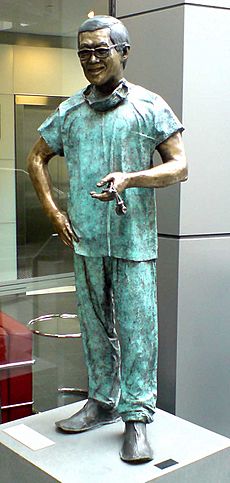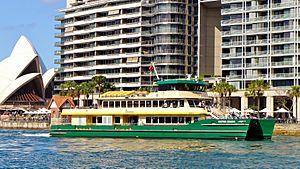Victor Chang facts for kids
|
||||||||||||||||||||||||||||||||||||||||||||||||||||
Victor Peter Chang was a famous Australian cardiac surgeon. He was born in China on November 21, 1936, and later became an Australian citizen. Dr. Chang was a true pioneer in modern heart transplantation in Australia. He helped many people by giving them new hearts.
Sadly, Dr. Chang was murdered in 1991. This event shocked Australia. He was given a special public funeral, which is a big honor. In 1999, people voted him "Australian of the Century" at the People's Choice Awards.
After studying medicine at the University of Sydney, he trained in the United Kingdom and the United States. He then returned to Australia. At St Vincent's Hospital, he helped create the National Cardiac Transplant Unit. This became Australia's top center for heart and lung transplants. Dr. Chang's team was very successful with heart transplants. He also worked on creating an artificial heart valve. In 1986, he received the Companion of the Order of Australia award. This was for his work in medicine and for helping build good relationships between Australia and China.
After his death, the Victor Chang Cardiac Research Institute was created. This institute continues his important work. The Victor Chang Lowy Packer Building at St Vincent's Hospital was also named in his honor.
Contents
Victor Chang's Early Life and School
Victor Chang was born in Shanghai, China. His parents were Chinese-British and were born in Australia. He grew up in Hong Kong. There he went to primary school in Kowloon Tong and spent two years at St. Paul's College.
In 1951, Victor's father, Aubrey, sent him and his younger sister to Sydney, Australia. They stayed with relatives there. Victor went to Belmore Boys' High School and finished his schooling at Christian Brothers' High School.
When Victor was 12, his mother died from breast cancer. This sad event made him want to become a doctor. He went to the University of Sydney for his medical studies. In 1962, he graduated with high honors in medicine.
Victor Chang's Medical Journey
Training to Become a Surgeon
After finishing medical school, Victor Chang started his training at St Vincent's Hospital. His mentor, cardiac surgeon Mark Shanahan, sent him to London for more training. There, he worked with British surgeon Aubrey York Mason.
In 1966, Chang became a Fellow of the Royal College of Surgeons. He specialized in cardiothoracic surgery at the Royal Brompton Hospital. While in London, he met and married his wife, Ann Simmons.
Dr. Chang then spent two years in the United States at the Mayo Clinic. He became the chief resident there. In 1972, he returned to St Vincent's Hospital. He became a top heart and chest surgeon. He also became a Fellow of the Royal Australasian College of Surgeons in 1973.
Amazing Work as a Surgeon
At St Vincent's Hospital, Dr. Chang worked with other great surgeons. One of them was Harry Windsor, who performed Australia's first heart transplant in 1968.
In the 1980s, new medicines made heart transplants much safer. These medicines helped stop the body from rejecting new organs. Dr. Chang worked hard to get money and support for a heart transplant program at St. Vincent's.
On April 8, 1984, Dr. Chang led a team of doctors in a special surgery. They performed a heart transplant on 14-year-old Fiona Coote. She became Australia's youngest heart transplant patient at the time.
Between 1984 and 1990, Dr. Chang's team performed over 197 heart transplants. They also did 14 heart-lung transplants. Their success rate was very high. About 90% of their transplant patients were still alive after the first year.
In 1986, Victor Chang was given the Companion of the Order of Australia award. This was for his important work in medical science. It also recognized his efforts to improve relationships between Australia and China.
Dr. Chang was worried about the shortage of organ donors. So, he gathered a team of scientists and engineers. They worked to create an artificial heart and affordable heart valves. They developed "St. Vincent's Heart Valves." These valves were used widely in Asia. Their company, Pacific Biomedical Enterprises Ltd, was the first in Asia to make heart valves for Asian patients. Dr. Chang and his team also made great progress on designing an artificial heart. Sadly, his research projects ended when he died.
Victor Chang's Death
On July 4, 1991, Victor Chang was tragically killed. He was shot in a failed attempt to get money from him. His body was found near his car in Mosman, a suburb of Sydney.
Remembering Victor Chang
Victor Chang was given a state funeral, which is a very high honor. His ashes were buried under a memorial plaque at Green Park, opposite St Vincent's Hospital. This sad event is remembered on the Victor Chang Cardiac Research Institute Website.
The People Involved
Two men, Chew Seng Liew and Choon Tee Lim, were involved in the crime. They had chosen Dr. Chang randomly after seeing him in a magazine. They caused his car to stop. When Dr. Chang refused to give them money, he was shot. Police first thought organized crime was involved. However, they later concluded it was an amateur act.
The Legal Outcome
Liew pleaded guilty and was sentenced to a long time in prison. Lim, who said he didn't know Liew had a gun, also received a long sentence. Another man, Stanley Ng, had tried to extort money from Dr. Chang before. He was given immunity for his help in the case. The plan had been to kidnap Dr. Chang and his family to force him to withdraw money. The judge called it an "absurd, improbable plan, always doomed to failure."
Both Liew and Lim were later released from prison and sent back to Malaysia after serving many years.
Victor Chang's Lasting Impact
In 1984, Dr. Chang started the Victor Chang Foundation. This foundation gives money to support education and new ideas in heart surgery. His daughter, Vanessa Chang, continues to lead the foundation today.
On February 15, 1994, the Victor Chang Cardiac Research Institute was launched. This institute focuses on finding ways to prevent, diagnose, and treat heart diseases. The "Dr Victor Chang Science Labs" at Christian Brothers' High School are also named after him.
In 1999, Prime Minister John Howard announced Victor Chang as "Australian of the Century." This was a big honor given at the People's Choice Awards. He was chosen over other famous Australians like swimmer Dawn Fraser and cricketer Donald Bradman.
At St Vincent's Hospital, the Victor Chang Lowy Packer Building was opened in 2008. Mary, Crown Princess of Denmark officially opened the building. She said that Dr. Chang was an "original thinker" who cared deeply for his patients and their families. Time magazine also recognized him as an important figure in the South Pacific from 1979–1989.
In 2017, a Sydney Ferries boat was named Victor Chang in his honor.
Victor Chang's Personal Life
Victor Chang met his wife, Ann Simmons, in 1966. He was an emergency doctor at a hospital in London. Ann came to the hospital after feeling unwell at a party. They had three children: Vanessa, Matthew, and Marcus.
Cars were a way for Dr. Chang to relax and enjoy himself. He loved restoring cars, like a 1950s MG TF. He also enjoyed driving many different cars, including a 1982 Citroën CX Prestige and several Porsches.
Victor Chang had two younger siblings, Frances and Anthony. Although he was not religious, he was known for his kindness. He would often ask a nun, Sister Bernice, to pray for his patients.
Images for kids





